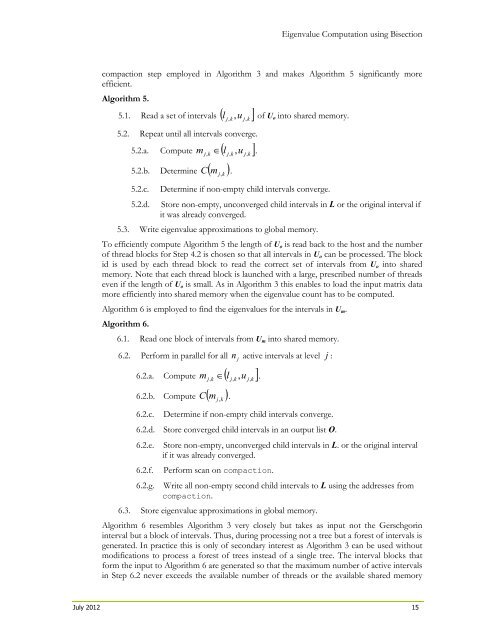Christian Lessig
SORtc
SORtc
- No tags were found...
Create successful ePaper yourself
Turn your PDF publications into a flip-book with our unique Google optimized e-Paper software.
Eigenvalue Computation using Bisection<br />
compaction step employed in Algorithm 3 and makes Algorithm 5 significantly more<br />
efficient.<br />
Algorithm 5.<br />
5.1. Read a set of intervals u <br />
l<br />
j k j,<br />
k<br />
5.2. Repeat until all intervals converge.<br />
5.2.a. Compute m<br />
j, k<br />
l<br />
j,<br />
k<br />
, u<br />
j,<br />
k<br />
<br />
5.2.b. Determine C ,<br />
.<br />
5.2.c.<br />
5.2.d.<br />
,<br />
, of U o into shared memory.<br />
.<br />
m j k<br />
Determine if non-empty child intervals converge.<br />
Store non-empty, unconverged child intervals in L or the original interval if<br />
it was already converged.<br />
5.3. Write eigenvalue approximations to global memory.<br />
To efficiently compute Algorithm 5 the length of U o is read back to the host and the number<br />
of thread blocks for Step 4.2 is chosen so that all intervals in U o can be processed. The block<br />
id is used by each thread block to read the correct set of intervals from U o into shared<br />
memory. Note that each thread block is launched with a large, prescribed number of threads<br />
even if the length of U o is small. As in Algorithm 3 this enables to load the input matrix data<br />
more efficiently into shared memory when the eigenvalue count has to be computed.<br />
Algorithm 6 is employed to find the eigenvalues for the intervals in U m .<br />
Algorithm 6.<br />
6.1. Read one block of intervals from U m into shared memory.<br />
6.2. Perform in parallel for all n<br />
j<br />
active intervals at level j :<br />
6.2.a. Compute m<br />
j, k<br />
l<br />
j,<br />
k<br />
, u<br />
j,<br />
k<br />
<br />
6.2.b. Compute C ,<br />
.<br />
6.2.c.<br />
m j k<br />
.<br />
Determine if non-empty child intervals converge.<br />
6.2.d. Store converged child intervals in an output list O.<br />
6.2.e.<br />
6.2.f.<br />
Store non-empty, unconverged child intervals in L. or the original interval<br />
if it was already converged.<br />
Perform scan on compaction.<br />
6.2.g. Write all non-empty second child intervals to L using the addresses from<br />
compaction.<br />
6.3. Store eigenvalue approximations in global memory.<br />
Algorithm 6 resembles Algorithm 3 very closely but takes as input not the Gerschgorin<br />
interval but a block of intervals. Thus, during processing not a tree but a forest of intervals is<br />
generated. In practice this is only of secondary interest as Algorithm 3 can be used without<br />
modifications to process a forest of trees instead of a single tree. The interval blocks that<br />
form the input to Algorithm 6 are generated so that the maximum number of active intervals<br />
in Step 6.2 never exceeds the available number of threads or the available shared memory<br />
July 2012 15


